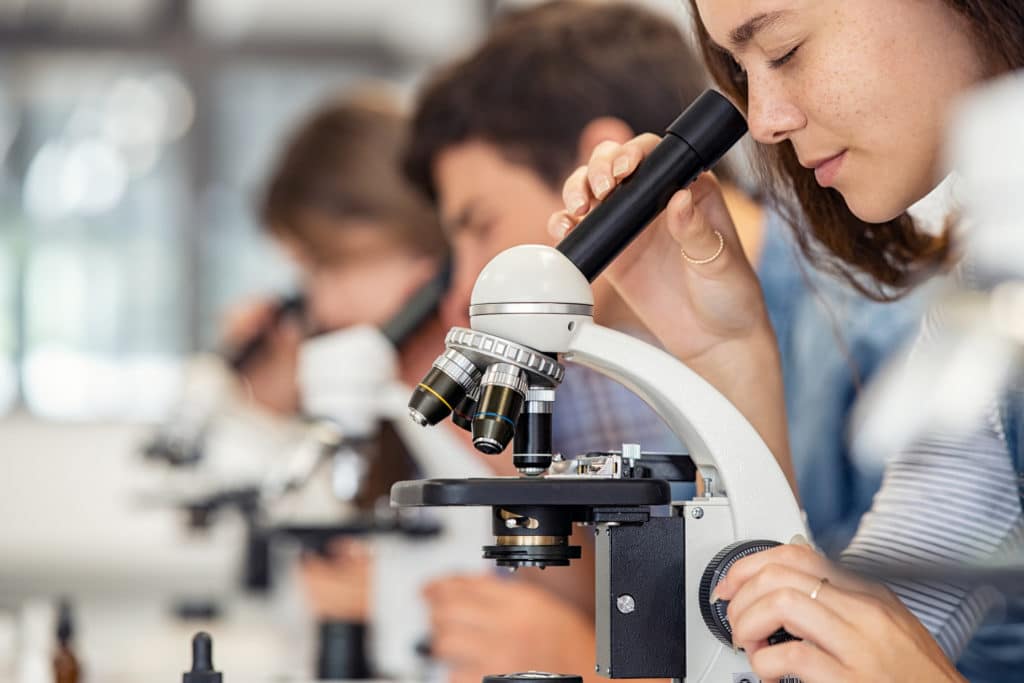What is CBE?
Competency-Based Education (CBE) is a student-centered methodology of instruction that incorporates elements of constructivist philosophy, 21st Century Skills education, and flexible learning models. Competency-based teaching methods differ from traditional teaching methods in pacing, structure, and goals.
CBE seeks to equip students with skills they can apply rather than have them memorize information that they could forget once they finish a course.
For this reason, CBE can be a stark change from traditional methods that most students are familiar with. The Michigan DOE states this regarding CBE:
“A CBE system wherein students advance based upon demonstrated mastery requires a comprehensive assessment system that combines assessment for learning (formative assessment) that guides learning toward the achievement of explicit, measurable and transferable learning competencies with an assessment of learning (summative assessments) that provides students with the opportunity to demonstrate mastery aligned to learning objectives and competencies.”
In science CBE courses, students are assessed on whether they can adequately use a skill rather than if they can select the correct answer on a multiple-choice exam.
Students often use the scientific method in the subject area of the course to solve problems or demonstrate subject-specific skills such as balancing chemical equations (chemistry) or determine likely phenotypes of offspring given specific genetic information about parents (biology/genetics).
This type of skill-focused approach has been shown effective even at the highest level of learning in science among medical school students and healthcare professionals, as well as in K-12 education.
When students have sufficiently shown that they are capable of applying their skills and knowledge, then we say that they have achieved mastery in an area of study.
This can be done in a variety of ways, including large-scale projects such as prototyping or research studies; smaller-scale demonstrations or simulations; multimedia producibles that communicate information in innovative, engaging, or highly-digestible formats; or even more “traditional” methods such as high marks on summative assessments.
How is science different in a CBE environment?
Frequently in science education, there are a large number of standards that teachers need to “cover” and teach to students, which can lead to some subjects being emphasized more than others due to a large focus on high stakes testing in many classrooms.
CBE science courses still teach the same standards but focus on the skills students will need to acquire to be effective and contributing members of society, embedding them within lessons that have content revolving around the standards.
For example, consider the Michigan Science Standard HS-LS3-2: “Make and defend a claim based on evidence that inheritable genetic variations may result from: (1) new genetic combinations through meiosis, (2) viable errors occurring during replication, and/or (3) mutations caused by environmental factors.”
A traditional way to teach this standard may be to require students to read a chapter in a science textbook, listen to a short teacher lecture, complete a few worksheets, and maybe watch a video. Then, students would be required to take a chapter test, which would include a multiple-choice or written response portion that addressed the standard.
A CBE science course may include many of the same components as the traditional method but would also focus on the skills that compose the standard:
- Make and defend claims based on evidence – This implies that students need to understand what is acceptable as evidence, and also implies that students need to be able to effectively communicate scientifically, which is a highly desired skill that science CBE seeks to build in students, especially in Michigan.
- Understanding meiosis – This implies that students understand what Meiosis is and why it is important. Students can demonstrate this by developing models that show the process (physical, digital, etc.) or construct a multimedia artifact that accurately depicts and teaches the process (this is communicating scientifically!).
- Understanding DNA replication – This implies that students understand what DNA is, why it must be replicated, and what can happen in the process. Students will need to be able to solve problems regarding cell division and inheritance of traits via genetic problems (Punnett squares and probabilities). This can be demonstrated, for example, by having students trace traits through their family tree and identifying genotypes and phenotypes of family members. Students could also construct a presentation regarding DNA replication and choose a disease/condition that affects it, giving them a high degree of choice in the content produced.
- Understanding mutations – This implies that students understand what a mutation is and why certain mutations can be beneficial or harmful based on environmental conditions or the nature of the mutations themselves. Students could document/collect/organize real-world examples of mutations that they encounter every day in a variety of species, creating a shared database with others that could be a useful learning tool outside of the classroom once students have finished the course.
A key difference in a CBE science course would be that students would be engaged in an activity where they must be able to effectively make and defend claims regarding the aforementioned topics.
Therefore, students would likely need to do such things as write a paper, engage in discussion or debate with others, and show how traits are passed from one generation to the next via a model, illustration, or constructed explanation (multimedia, oral, or audio-visual). The Michigan DOE states this regarding assessment in CBE:
“To achieve learning outcomes that include the application of knowledge and the development of skills and dispositions, assessment must be a meaningful and positive learning experience for students.”
The instructor can set these competency-based expectations as criteria to display mastery, but students often have choices on how they go about displaying their mastery as well, which can lead to highly individualized assignments and projects.
Students will also be provided with many resources by their teachers, such as reading material, videos, or other content to help give them context and understanding of the subjects they are studying.
More of the responsibility for ingesting information is placed on the learner because of the flexible nature of CBE courses and their focus on staying student-centered through the use of constructivist strategies, as discussed earlier.
How do I make sure my student succeeds?
Competency-based courses can be challenging for many students because of the change in pace and structure and can require that learners make adjustments. To make sure that students can be successful in competency-based science courses, consider the following:
Students are expected to apply what they have learned. In science, this means actually being able to do science (replicate experiments, follow the scientific method) and show their learning of important concepts in a variety of ways that may not always include simple tests and worksheets (for example, designing prototypes, synthesizing existing research, producing multimedia, or developing a program or process).
Simply put, students will need to be able to produce and evaluate acceptable evidence to make logical conclusions. Because of the abundance of information that exists in the world today, this is more critical than ever.
Resources and tools for students
Students will find that much of the digestion of information in science CBE courses is firmly in their hands in many cases, as is the matter of showing what they learned.
Here are some tools to keep in mind for students as they endeavor to complete their CBE courses in science:
- Froguts – An online dissection and biology/genetics tool that can be downloaded to desktops for offline use as well.
- Physics Interactives – A repository from physicsclassroom.com has many browser-based simulators and activities to help students understand many physics principles and concepts. There are also many other tools beyond simulations as well.
- Science Friday – Videos and podcasts that are digestible for on-the-go learners on a variety of topics. They also boast replicable experiments and activities for learning important science concepts, all conveniently organized by topic, grade level, and time-to-complete.
- Cells alive! – Many activities, videos, and repositories regarding biology-based topics.
- Interactive Periodic Table – Awesome interactive tool for chemistry students; contains all the information you need regarding each element, including electron affinities, specific heat, electronegativities, and much more. Also includes the capability to provide the same information for isotopes and compounds.
- PhET Simulations – Award-winning simulations for all grade levels, including earth science, biology, physics, chemistry, and math.
- Codeacademy – Focused on computer science, includes sample projects for learners to hone their skills, as well as cheat sheets for different programming languages and subjects.
Final thoughts
While CBE in science courses can be a little daunting for students who are used to the traditional lecture-based mode of teaching, the experience of mastering skills and doing science can be highly beneficial. Remember that a student’s number one resource should be their instructor as well and that teachers are always there to help and guide students as they learn.
For more information on CBE, check out our previous research blogs about classroom challenges and CBE and how CBE is designed for student success.
Competency-Based Education Blog Series
In our Competency-Based Education Blog Series , we explore CBE in terms of tools for parents, teachers, and students. Next month’s topic will be Enter the Matrix of CBE Tools. Stay up to date on future blogs in this series by signing up for email notifications!

